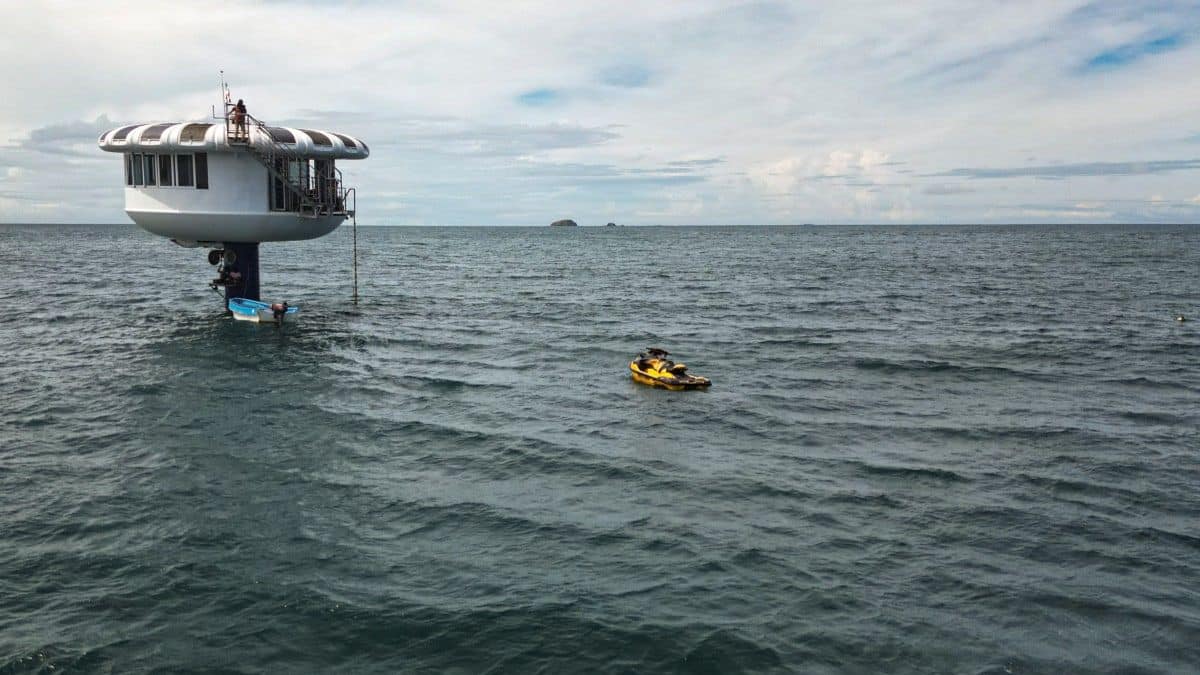Rüdiger Koch, a 59-year-old aerospace engineer, has recently broken world records by living underwater for an astounding 120 days. His groundbreaking experiment, completed in early 2025, demonstrates how humans might adapt to subsea environments using surprisingly simple yet effective technologies. Koch’s underwater home experiment offers fascinating insights into potential solutions for climate challenges while showcasing human adaptability in extreme conditions.
Pioneering underwater living: Koch’s record-breaking experiment
On January 24, 2025, Rüdiger Koch emerged from his underwater dwelling after spending four consecutive months beneath the ocean’s surface. The aerospace engineer’s home during this period was a compact 30-square-meter capsule situated 11 meters underwater near Puerto Lindo, Panama. This extraordinary achievement wasn’t merely a personal challenge but represented a significant step toward exploring alternative living solutions.
Koch’s underwater residence featured basic amenities despite its limited space. He equipped his capsule with:
- A comfortable sleeping area
- Computer workstation
- Television for entertainment
- Exercise bicycle for maintaining physical fitness
- Satellite internet connection
Solar panels provided power to the underwater habitat, enabling Koch to maintain contact with the outside world throughout his extended stay. The engineer faced numerous challenges during his 120-day submersion, including the notable absence of shower facilities and limited personal space. These constraints tested both his physical endurance and psychological resilience.
Koch’s experiment has garnered international attention from scientists, environmental specialists, and futurists interested in exploring underwater habitation possibilities. His success demonstrates that with proper preparation and technological solutions, humans can adapt to underwater environments for extended periods.
America Spots China’s Giant Fusion Laser During Reconnaissance Flyover
For the First Time in 160,000 Years, This Rare Comet Will Be Visible Without a Telescope
Breathing innovation: the simple technology keeping Koch alive
The most remarkable aspect of Koch’s underwater living experiment was the surprisingly uncomplicated system that allowed him to breathe normally throughout his four-month stay. Rather than relying on complex oxygen generation equipment, Koch implemented a straightforward air pumping mechanism that delivered surface air to his underwater capsule.
This ingenious system regulated air pressure within the habitat to maintain safe breathing conditions despite being submerged at significant depth. The technology’s relative simplicity belies its effectiveness—Koch’s breathing apparatus functioned flawlessly throughout the 120-day period, requiring minimal maintenance or adjustment.
While breathing underwater was Koch’s primary technical challenge, the success of his experiment relied equally on addressing psychological factors. Living in isolation within a confined space presented substantial mental hurdles. Koch developed specific strategies to manage potential psychological strain:
| Challenge | Solution |
|---|---|
| Isolation | Regular video communication with family and colleagues |
| Confined space | Daily exercise routines on stationary bicycle |
| Monotony | Varied digital entertainment and research projects |
| Stress management | Meditation and breathing techniques |
The integration of these psychological coping mechanisms with the technical breathing solution created a comprehensive approach to underwater habitation that proved successful beyond expectations.
A Secret Ocean 700km Underground? Scientists Confirm Stunning Discovery
A Combustion Engine That Pollutes Nothing: 440 Horsepower and Only Water as Output
Future horizons: underwater habitats as climate solutions
Koch’s record-setting underwater residence represents more than personal achievement—it’s part of a broader vision for addressing pressing global challenges. As co-founder of Ocean Builders, Koch has been actively developing underwater habitat concepts as potential solutions to rising sea levels and land overcrowding issues.
According to Grant Romundt, Koch’s business partner, these subaquatic living spaces could provide viable alternatives for coastal communities threatened by climate change. The technology demonstrated during Koch’s 120-day experiment offers promising applications for developing sustainable underwater or floating homes that could withstand environmental disasters while maintaining comfortable living conditions.
Similar initiatives are gaining momentum globally. The UK-based “Deep” project aims to establish permanent underwater housing for both scientific research and private residency by 2027. These pioneering efforts suggest that subsea habitation may transition from experimental concept to practical reality within the coming decade.
While significant challenges remain—including construction costs, resource management, and ecological impact considerations—Koch’s successful experiment provides valuable data for addressing these obstacles. The future of underwater living requires balancing technological innovation with environmental responsibility, a challenge that Koch and similar visionaries continue working to solve.
As humanity faces increasingly complex environmental pressures, Koch’s underwater breathing innovation and successful extended stay beneath the waves offer inspiring possibilities for adapting to our changing planet.







